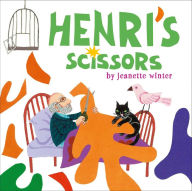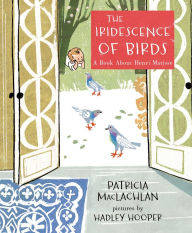Step into the colorful world of Henri Matisse and his magnificent paper cutouts!
In a small weaving town in France, a young boy named Henri-Emile Matisse drew pictures everywhere, and when he grew up, he moved to Paris and became a famous artist who created paintings that were adored around the world. But late in life a serious illness confined him to a wheelchair, and amazingly, it was from there that he created among his most beloved works—enormous and breathtaking paper cutouts.
Based on the life of Henri Matisse, this moving and inspirational picture book biography includes a note from the author, dynamic quotes from Matisse himself, and an illuminating look at a little-known part of a great artist’s creative process.
Publishers Weekly
After quickly tracing French painter Matisse’s journey to becoming an artist (“He was happy, and his paintings made people happy”) and explaining how illness left him unable to paint at the end of his life, Winter (Kali’s Song) describes his discovery of a medium less physically demanding than painting but just as expressive: painted paper and scissors. “Why didn’t I think of it earlier?” he asks delightedly. Simple, folk-style paintings show Matisse in a wheelchair in a studio amid his collages; in a quiet visual cue, a plant with oversize leaves suggests inspiration for their big, organic shapes. He continues to create until his death, another moment Winter handles gracefully: “The rainbow of shapes cradled the old artist and carried him into the heavens.” Old age can be fertile and useful, Winter implies; disability doesn’t mean the end of creating, and triumph is possible where only sadness could have been foreseen. All of these messages lie obliquely in the text, but even readers who don’t dig that deep will share Matisse’s joy. Ages 5–8. Agent: Susan Cohen, Writers House. (Aug.)¦
September-October 2013 Horn Book Magazine
"In her latest picture book biography...Winter focuses on Henri Matisse’s later life, during which the painter took up collage.... With text that is straightforward and unflowery, Winter relies, successfully, on the strength of her own art to capture the essence of Matisse’s. A brief author’s note explains her specific interest in this portion of the artist’s oeuvre."
The New York Times Book Review, August 25 2013 - Dan Yaccarino
In ‘Henri’s Scissors,’ Jeanette Winter rushes through the story of Henri Matisse’s childhood, but no worries: it’s his second (far more interesting) childhood that fascinates her. After becoming one of the greatest artists of the 20th century, whose only peer, it could be argued, was the aggressively prolific Picasso, Matisse has grown old. Now infirm and confined to bed, he reflects on his past triumphs in a room colored in the deepest blues and purples. But inspiration strikes, and using a pair of common household scissors as his magic wand, Matisse cuts shapes out of brightly colored paper and transforms his sick-room into a mystical garden full of flowers and birds. Then, in the final and greatest feat of his career as artist-sorcerer, ‘the rainbow of shapes cradled the old artist and carried him into the heavens.’
October 2013 The Bulletin of the Center for Children’s Books
"The accessibility of cut paper makes it a particularly child-appealing medium, and Matisse is certainly the grand master of the art, so audiences will be pleased to see the championing of this oeuvre...the art is strong and vigorous, with a hat-tip to Matisse himself in the form of the open window (a famous Matisse subject) that allows the old man to view the sea; the playfulness and imaginative employment of actual Matisse collage shapes effectively convey the way art and life vision can blend together."
January/February 2014 Library Media Connection
"The young reader gets a taste of Matisse’s art and a flavor of his creativity in the late period of his life.... Share this picture book biography with the art teacher. Incorporate the title in a story hour about imagination, color, or the beginnings of modern art."
Booklist
* “Masterful picture-book biographer Winter (The Watcher, 2011) offers an elegant, accessible portrait of expressive artist Henri Matisse…. As an old man, Matisse becomes ill, and the book turns a stylistic corner, spending the balance of its pages exploring the changes in his circumstances and the subsequent development of his medium and his genius. Unable to paint, he begins cutting shapes from paper and dives into the process, allowing his shapes to grow with his imagination. And the book adapts in turn, the imagery now sprawling across pages, filling the space with rich color in exuberant compositions…. With a gentle narrative dotted with quotes from the artist himself, luminous illustrations, and a warm, celebratory spirit, this exemplary picture-book biography delivers a clear, sensitive portrait of the whole man, story and soul alike.
October 2013 The Bulletin of the Center for Children’s Books
"The accessibility of cut paper makes it a particularly child-appealing medium, and Matisse is certainly the grand master of the art, so audiences will be pleased to see the championing of this oeuvre...the art is strong and vigorous, with a hat-tip to Matisse himself in the form of the open window (a famous Matisse subject) that allows the old man to view the sea; the playfulness and imaginative employment of actual Matisse collage shapes effectively convey the way art and life vision can blend together."
Children's Literature - Kathleen Karr
How often is the aging--nay, dying--artist made the subject of a children’s picture book? Successfully? Jeanette Winter takes on this task with grace in her brief biography of Henri Matisse, with emphasis on his final creative period. Yes, this is the story of how little Henri draws over everything, including his law cases, before abandoning a bourgeois provincial existence for ART in Paris. But most especially it is the story of Matisse at the end of his full and fulfilling painting life. He may be stuck as an invalid in bed, but he can still create. And his lovely, soaring silhouettes seem meant, like a soul, for soaring into the heavens. It is fascinating to learn that the artist did have a little help: a small army of assistants who prepared the colored papers for him! Winter’s Matisse-inspired illustrations are rendered in acrylic paint and--like Henri himself--cut paper. For children (adult readers, too!) charmed into a desire to actually see one of Matisse’s finished silhouettes, please note that the recently moved Barnes Foundation in Philadelphia owns and displays one of the huge creations. Reviewer: Kathleen Karr AGERANGE: Ages 5 to 8.
Kirkus Reviews
In her extensive picture-book–biography oeuvre, Winter has proven to be particularly attuned to selecting the just-right elements of her subjects' complex lives while making them both accessible to and readily understood by young children. Here she limns the major biographical details of Matisse's long life: A French law student recovering and on bed rest after an appendectomy is given a paint set; he discovers his true calling, abandons the law, moves to Paris and embarks on a long career as a member of the Fauvist movement. Many years later, once again bedridden and frail, he begins the final and perhaps most enduring stage of his work. Winter both describes and employs Matisse's signature, late-career technique of brilliantly colored, hand-painted, cut-paper compositions. She enlivens the simple text with liberal yet judicious quotes from Matisse's letters and comments from contemporaries. This is a beautifully designed book that will certainly connect with readers, although the closing spreads may be too poetically obscure for the intended school-age audience. Winter writes that at Matisse's death, "the rainbow of shapes cradled the old artist and carried him into the heavens." The book's final question, "Are some of the stars we see at night coming to us from Henri's scissors?" seems forced. This soaringly sentimental resolution notwithstanding, the book is a charming introduction to a widely reproduced, child-friendly artist, one that children will assuredly encounter and affirmingly embrace. (author's note) (Picture book/biography. 5-8)
School Library Journal
K-Gr 3—At age 72, following surgery for cancer, Henri Matisse was too weak to paint. During his convalescence at the seaside, he picked up scissors and began cutting shapes from painted paper. In his own words, "It seems to me that I am in a second life." Winter's picture-book biography focuses on that second life, neatly summarizing his childhood and career in the first eight pages: "He kept on painting, forgot about law, and left his small town to be an artist in Paris." Winter captures the joy that Matisse found in cut paper, both through her acrylic and cut-paper illustrations and through quotes from his letters. The images are evocative of his art, with bright colors and rounded shapes. The first pages, depicting his youth and adulthood, are deeply framed like museum art, then transition to full-page compositions when his life changes due to illness. The author addresses his death with a light touch: "Then one night, Matisse walked into his paper garden, and the rainbow of shapes cradled the old artist and carried him into the heavens," where perhaps he now uses his scissors to make the stars in the night sky. Libraries with demand for picture-book biographies and art history will want to add this well-done title to their collections.—Suzanne Myers Harold, Multnomah County Library System, Portland, OR
Read More
















